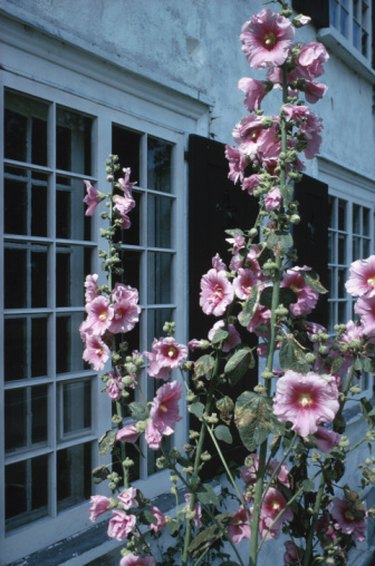
Hollyhocks are technically biennial flowering plants, although most gardeners grow them as hardy annuals or self-seeding perennials. If you want to plant hollyhocks, you should choose a location that has full sunlight exposure--at least six hours of sunlight per day. Hollyhocks will grow 2 to 6 feet tall, depending on the specific variety, but they won't survive in shady areas.
Location
Video of the Day
Hollyhocks (Alcea rosea) require full sun in order to grow properly and bloom. They also need well-draining, fertile soil that doesn't become waterlogged or soggy after heavy rains. In spring after all chance of frost has passed, you can plant hollyhocks from seed and grow them as hardy annuals. Hollyhocks often reseed themselves, and the seeds sometimes sprout the following spring.
Video of the Day
Landscaping
Hollyhocks can serve as background plantings for flower beds due to their tall stature. The flowers will show up well behind other low-growing annual flowers. Hollyhocks come in a wide variety of flower colors as well, including white, yellow, pink, red and purple. The different cultivated varieties, or cultivars, also range in size from dwarf forms to varieties that grow up to 6 feet tall or higher. In addition to the A. rosea species, A. rugosa is another species of hollyhocks with yellow flowers that bloom atop 6-foot-tall spikes.
Types
Chater's Purple has double-blooming, ball-shaped flowers. Country Garden Mix and Indian Spring bloom in single flowers mixed with shades of pink, white, red and yellow. Powderpuffs Mixed has large, double flowers in yellow, white, pink, scarlet and salmon. Summer Carnival also blooms in double flowers in many different hues.
The Nigra cultivar is unique among hollyhock varieties with dark-maroon flowers with nearly black centers. Majorette Mixed is a dwarf form, growing up to just 2 1/2 feet with large, semi-double flowers. Old Barnyard Mix are biennial hollyhocks that reseed each year, blooming in single flowers, while Peaches 'n' Dreams blooms in double pink blossoms with yellow centers. Watchman Strain has single, dark-red blossoms.
Tips
If you decide to grow a taller hollyhock variety, you should stake them to prevent them from falling over in windy conditions. Alternatively, you can pinch back their main stems to encourage the hollyhocks to grow in a more compact form. Hollyhocks are highly susceptible to foliar diseases, especially rusts, leaf spots and anthracnose. Proper spacing and good air circulation can help to prevent rust diseases. Hollyhocks are also susceptible to infestations of certain insects, such as Japanese beetles, thrips and two-spotted spider mites.